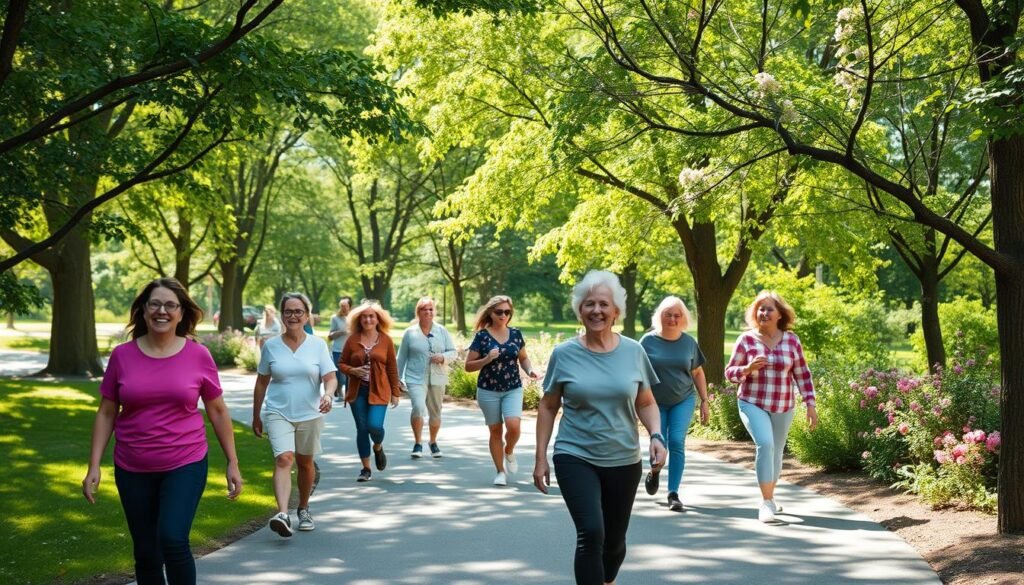Did you know that walking for just 30 minutes a day can cut heart disease and stroke risk by up to 35%? This simple exercise can greatly improve your health and mood. Walking helps with weight control, boosts metabolism, and lifts your mood.
Studies show that the most benefits of walking daily are keeping joints flexible and release endorphins, reducing stress and anxiety. They also help grow new brain cells, improving your thinking skills.

Walking is easy and doesn’t need any special gear or gym membership. It’s perfect for a busy schedule, promoting a healthier life. Just a few steps a day can lead to big health benefits, making your life longer and happier.
Key Takeaways
- Walking for 30 minutes daily can significantly lower heart disease risk.
- Helps in weight management by burning calories.
- Strengthens muscles, enhancing stability and balance.
- Improves mental well-being by reducing stress and anxiety.
- Promotes joint health, specially useful for those with arthritis.
- Encourages brain function enhancement through new neuron growth.
The Science Behind Walking and Health
Scientific studies prove walking is great for our health. It helps keep weight in check and lowers body fat. It also boosts heart health by improving blood flow and reducing blood pressure.
This can help prevent heart disease, stroke, and type 2 diabetes. Walking science shows that 150 minutes of moderate activity a week is key. The Department of Health and Human Services agrees, saying it’s vital for our well-being.
Walking daily can also lower cancer risks and manage chronic conditions. It’s a simple way to improve our health. Just five minutes a day can make a big difference over time.
Adults should aim for 60 minutes of walking daily. Keeping track of your progress can keep you motivated. It’s a small step towards a healthier life.
Walking does more than just keep us fit. It also sharpens our minds, improving memory and problem-solving. It’s a key part of living a healthy life. People in Blue Zones, known for their longevity, show us how walking can add years to our lives.

Benefits of Walking Daily
Walking every day is great for your health. It’s a simple way to keep your heart healthy, prevent chronic diseases, and boost your mood.
Boosting Cardiovascular Health
Walking makes your heart rate go up and gets your blood flowing. It helps lower blood pressure, control blood sugar, and manage cholesterol. These changes can lower your risk of heart disease and stroke.
Reducing the Risk of Chronic Diseases
Walking daily is a strong way to prevent chronic diseases. It can lower your risk of type 2 diabetes, cancer, and arthritis. Regular walking also strengthens your bones and reduces osteoporosis risk.
Enhancing Mental Health
Daily walks are good for your mind too. They help reduce stress and lower depression risk. Walking can also improve your memory and lower dementia risk. People who walk regularly feel more energetic and emotionally better.

How 30 Minutes a Day Makes a Difference
Walking for 30 minutes a day can make a big difference in your health. Studies show that this simple habit can greatly improve your well-being. It can even lower the risk of serious diseases like obesity, high blood pressure, and type 2 diabetes.
A 2022 study in Nature Medicine found that walking about 8,200 steps a day can reduce these risks. Walking also helps your heart stay healthy. People who walk enough have a 30% lower chance of heart problems.
Adding longer walks, like one hour a week, can help even more. Even just two minutes of walking after meals can lower blood sugar. This shows how important walking is for managing diabetes.
Walking regularly makes your muscles stronger and improves balance. It also lowers the risk of falls, which is good for older adults. Walking daily helps keep you fit, manage your weight, and build muscle.
But the best part is, walking makes you feel better. It reduces anxiety and stress. This shows how walking 30 minutes a day can improve your life in many ways.
Understanding Physical Activity Guidelines
Physical activity guidelines help us move in a healthy way. They tell us to do at least 150 minutes of moderate exercise each week. This is key for adults to stay healthy and well.
150 Minutes of Exercise Each Week
Many health groups say we should do 150 minutes of moderate exercise weekly. Walking fast can be part of this. It boosts heart health and lowers disease risks.
Meeting the Recommended Standards
Knowing how to walk right is important for daily exercise. Start slow to reach 150 minutes a week. This helps you stick with it.
For those under 60, 8,000 to 10,000 steps daily is good. Over 60, 6,000 to 8,000 steps daily is enough. These steps help you stay healthy.
The Importance of a Walking Routine
Starting a walking routine boosts your health a lot. It brings long-term benefits, making it key to your daily routine. Adding walks or movement breaks into your day helps make walking a natural part of your life.
Studies show walking’s benefits. For example, women with heart disease who walked faster had a 28% lower death risk. This shows walking speed is important for health.
Light walking during the day also helps blood sugar levels more than standing. This shows walking improves both fitness and metabolic health.
Walking also improves mental health. It lowers anxiety and depression, and boosts self-esteem and emotional strength. Brisk walking can make you feel better and less lonely, showing its mental health benefits.
Just 20 to 30 minutes of brisk walking a day can be very beneficial. It can lower risks of strokes, diabetes, and some cancers. This regular effort can improve your fitness and lower disease risks.
Exploring Brisk Walking
Brisk walking is a fast-paced walk that gets your heart rate up. It’s about moving at 3 to 4 miles per hour. This type of walk is great for your health and easy to fit into your day.
What is Brisk Walking?
Brisk walking is faster than regular walking. It’s key for improving your fitness. Walking briskly daily boosts your heart health. It helps you meet exercise goals and stay active.
Benefits of Walking at a Brisk Pace
Walking quickly is not only refreshing but also good for your health. Some benefits include:
- Increased heart rate, promoting better cardiovascular function.
- Reduced risk of stroke, notably in women who walk often.
- A big drop in hip fracture risk with daily walks.
- Strong evidence shows brisk walking lowers death rates in older adults.
- It also boosts mental health, reducing insomnia and memory loss.
Just 10 minutes of brisk walking daily can meet weekly exercise goals. It’s not just for weight loss or disease prevention. Brisk walking also strengthens your immune system, helping fight off infections.
Increasing Your Daily Step Count
Boosting your daily step count is key for better health and happiness. Using smart walking strategies makes it easy to become more active. Here are some easy ways to add more walking to your day.
Strategies to Incorporate Walking into Your Day
- Choose the stairs over elevators. This simple change can really help your step count.
- Take breaks to walk during work. It’s a great way to stretch and clear your mind.
- Go for walks after meals. It’s good for your digestion and step count.
- Walking your dog is a great way to stay active. It’s fun and keeps you moving.
- Listen to music or podcasts while walking. It makes the walk more fun and keeps you going.
- Make family walks a regular thing. It’s a fun way to spend time together.
- Instead of emailing, walk to talk to coworkers. It’s a small change that adds up.
- Park further away to get more steps. It’s easy and doesn’t require extra effort.
Setting daily goals, like aiming for 10,000 steps, helps you stay motivated. Tracking your progress makes it easier to keep walking. Research shows that more steps mean better health, including a lower risk of death. Even small increases can make a big difference in your health.
Walking for Weight Management
Walking is a great way to manage your weight. It’s simple yet powerful. Walking one mile burns about 107 calories, helping you lose weight with a balanced diet.
Walking boosts your metabolism, burning calories even when you’re not moving. Studies show people who walk daily manage their weight better. In fact, 94% of those who keep weight off walk more.
The Centers for Disease Control suggest 150 minutes of moderate activity weekly. That’s about 22 minutes of walking each day. Walking more than 300 minutes a week brings even more benefits for losing and keeping off weight.
Walking for 30 to 60 minutes daily is best. Even a 15-minute walk can cut down on cravings for sweets. Adding hills or intervals to your walks can burn more calories and help with weight management.
Remember, walking is just part of the equation. You also need a healthy diet full of fruits, veggies, and whole grains. Avoid too much saturated fat and sugar. This balanced approach helps you lose and keep off weight effectively.
Health Benefits of Walking Daily for Older Adults
Walking is great for older adults. It boosts joint health and improves mobility. These benefits are key as we age. Knowing them can encourage seniors to walk regularly.
Joint Health and Mobility
Walking is a low-impact exercise that helps older adults. It eases arthritis pain and boosts mobility. Regular walks strengthen muscles and improve balance, lowering fall risks.
Walking and Age-Related Conditions
Walking is vital for managing age-related conditions. The CDC suggests walking 150 minutes weekly for those 65 and older. It helps with heart disease and diabetes.
Walking for 15 minutes after meals also helps control blood sugar. Studies show walking improves circulation, lowers blood pressure, and enhances sleep. Walking is a simple, affordable way to improve health and reduce risks.
Choosing the Right Walking Shoes
Choosing the right walking shoes is key to a better walking experience. Comfortable shoes support your feet and prevent injuries. This lets you walk longer without pain. Look for these features in your ideal pair:
- Cushioning: Good cushioning absorbs shock and reduces the impact on your joints.
- Arch Support: Proper arch support keeps your feet aligned and prevents fatigue.
- Durability: Quality materials ensure that your shoes can withstand regular wear.
- Fit: Ensure the heel fits snugly to keep your foot secure while walking. It’s beneficial to try shoes in the afternoon when your feet may be slightly swollen.
The right shoes improve your walking performance. They offer stability and comfort, helping you avoid injuries. Choose shoes that prioritize support and cushioning for a comfortable walk.
As you start walking, remember your shoes are crucial. They help you enjoy the journey and its health benefits. Make sure your shoes are ready to support you on your path to wellness.
Tracking Your Progress
Keeping an eye on your walking journey can really boost your commitment to staying active. Tools like walking apps and pedometers make it easy to track your progress. This not only keeps you motivated but also shows the benefits of regular walking.
Using Apps and Pedometers
Walking apps are great for logging your daily activity. They track steps, distance, and calories burned, helping you set and reach walking goals. Pedometers, whether you wear them or use a mobile app, show how much you move each day.
Using these tools, many people see their fitness improve. They start with short walks and soon do journeys over ten miles.
Setting Walking Goals
Setting clear walking goals helps you keep improving. Goals like reaching 10,000 steps a day motivate you to stay active. It’s smart to start with achievable goals and increase them as you get better.
Regularly checking your progress gives you insights into your success. It helps you adjust your approach. Writing down your thoughts and goals can boost motivation and make them stick in your mind.
Joining a Walking Group
As National Walking Month approaches in May, the appeal of joining a walking group increases. Being part of a walking group boosts physical activity and social interaction. It makes walking more enjoyable. These groups offer a support system that helps keep everyone motivated and accountable.
Walking with others has many benefits. It can lower anxiety and depression, improve mood, and boost self-esteem. Plus, it reduces stress, lowers blood pressure, and strengthens the immune system.
- Meeting new people and building meaningful relationships
- Gaining a sense of community
- Establishing a consistent walking routine
- Experiencing a sense of purpose and achievement
Research shows walking groups improve health. They can lower blood pressure and cholesterol levels. People often feel more energized and confident after walking.
Some might worry about fitting in or feeling out of place. But, many find walking groups less intimidating than gyms. Programs like Walk Across Texas offer flexible ways to make walking a daily habit.
Staying Safe While Walking
Walking is a great way to stay active, whether in the city or nature. Knowing how to stay safe makes these walks better and safer.
Tips for Urban Walking
Walking in the city can be fun if you’re careful. Here are some tips to help you stay safe:
- Use well-lit paths: Choose bright routes, like during daylight hours.
- Walk against traffic: This makes it easier to see cars coming.
- Be aware of your surroundings: Watch out for people, bikes, and cars.
- Wear bright, visible clothing: Make it easy for drivers to see you.
Walking in Nature
Nature walks are good for your body and mind. To stay safe, follow these tips:
- Check trail conditions: Know the path before you go.
- Understand local wildlife: Learn about the animals and what to do if you meet them.
- Bring necessary supplies: Take water, a map, and wear good shoes.
- Leverage outdoor groups: Join walking clubs to walk with others and share stories.
Mindfulness and Enjoyment in Walking
Mindfulness walking turns a simple walk into a deep practice. By focusing on your surroundings, you enjoy walking more. Every step lets you connect with nature, like the sound of leaves or the smell of fresh air.
Studies show walking benefits from mindfulness. Even a short walk can help with mild depression and anxiety. Walking outside in green spaces makes you happier and more attentive, letting you see the beauty around you.
Mindful walking deepens your bond with the environment. It makes you more present, improving your mood and emotional control. It’s a way to care for your mental health and see life in a new light.
Adding mindfulness to your walks boosts your well-being. Meditative walking is good for both your body and mind, lowering stress and anxiety. Walking in nature brings positive feelings and refreshes your spirit.
By making mindfulness a part of walking, you strengthen this skill. Spend 30 to 35 minutes on meditative walks to increase your steps and daily joy. People who walk mindfully often see better moods, thinking, and mental clarity.
Conclusion
Walking every day brings many benefits that improve our overall health. It helps our heart stay healthy and our minds clear. Walking is easy and fun, and it fights off chronic diseases like anxiety and depression.
Walking, whether fast or slow, helps us fight off diseases and makes us feel better. Starting small and walking more can make it a habit. Walking outside is even better for our mental health, showing how exercise and mental health are closely linked.
Walking every day is key to a healthier life. It helps us feel happier, more confident, and improves our social life. By understanding how walking helps us, we can make it a part of our daily routine for better health.
FAQ
What are the primary Benefits of Walking Daily for health?
Walking is great for your health. It improves your heart health and boosts your mood. It also lowers the risk of diseases like heart disease and diabetes. Plus, it helps with weight management and fitness.
How much should I walk each day to see health benefits?
Aim for 30 minutes of brisk walking daily. This meets health guidelines for weekly exercise.
Is brisk walking better than regular walking?
Yes, brisk walking is better for your heart. It burns more calories and improves your mood.
Can walking really help with mental health?
Absolutely! Walking daily can make you feel better. It reduces stress and boosts creativity.
How can I easily incorporate more walking into my day?
Try taking the stairs or walking during breaks. Joining a walking group or setting goals like 10,000 steps a day can also help.
What type of walking shoes should I wear?
Choose shoes that are comfy and supportive. Look for cushioning, arch support, and durability to avoid injuries.
Are there safety tips I should follow while walking?
Yes, safety is key. Use well-lit paths and walk against traffic. Wear visible clothes and be aware of your surroundings. Consider trail conditions and wildlife if walking in nature.
How can I track my walking progress effectively?
Use apps and pedometers to track your steps. Set goals and review your progress to stay motivated.
Can older adults benefit from regular walking?
Yes, walking is good for older adults. It keeps joints healthy, increases mobility, and helps manage age-related diseases.
Source Links
- 5 Ways Walking Can Boost Your Brain Health – https://www.aarp.org/health/brain-health/info-2023/ways-walking-improves-your-brain.html
- Walk your way to fitness – https://www.mayoclinic.org/healthy-lifestyle/fitness/in-depth/walking/art-20046261
- The multifaceted benefits of walking for healthy aging: from Blue Zones to molecular mechanisms – https://pmc.ncbi.nlm.nih.gov/articles/PMC10643563/
- Why Is Walking the Most Popular Form of Exercise? – https://www.heart.org/en/healthy-living/fitness/walking/why-is-walking-the-most-popular-form-of-exercise



